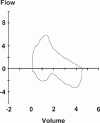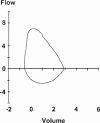Seeing the Forest Through the Wheeze: A Case-Study Approach to Diagnosing Paradoxical Vocal-Cord Dysfunction
- PMID: 12937589
- PMCID: PMC164363
Seeing the Forest Through the Wheeze: A Case-Study Approach to Diagnosing Paradoxical Vocal-Cord Dysfunction
Abstract
OBJECTIVE: To present for discussion a case of paradoxical vocal-cord dysfunction (PVCD), an uncommon disorder that may be misdiagnosed as, or coexist with, exercise-induced asthma (EIA). BACKGROUND: Vocal-cord dysfunction results from paradoxical closure of the vocal cords during the inspiratory phase of respiration and may be mistaken for EIA, resulting in unnecessary medical treatment and a delay in diagnosis. Although PVCD is uncommon, athletic trainers should be aware of the disorder, as they may play an important role in its diagnosis and treatment. DIFFERENTIAL DIAGNOSIS: Exercise-induced asthma, foreign body aspiration, anaphylactic laryngeal edema, bilateral vocal cord paralysis, extrinsic airway compression, laryngomalacia, subglottic stenosis, traumatic edema, or hemorrhage. UNIQUENESS: This case report describes a common presentation of an unusual disorder. By obtaining a detailed history from the athlete and having a high index of suspicion for the disease, we were able to diagnose PVCD, discontinue all EIA medications, and begin treatment. CONCLUSIONS: The athletic trainer can play a valuable role in the diagnosis of PVCD, which must be considered in the differential diagnosis for any athlete who is compliant with the medications prescribed for the treatment of EIA yet shows little or no improvement in symptoms. A high index of suspicion for PVCD will greatly aid health care professionals assessing the athlete.
Figures
Similar articles
-
Psychogenic Respiratory Distress: A Case of Paradoxical Vocal Cord Dysfunction and Literature Review.Prim Care Companion J Clin Psychiatry. 1999 Apr;1(2):39-46. doi: 10.4088/pcc.v01n0203. Prim Care Companion J Clin Psychiatry. 1999. PMID: 15014694 Free PMC article.
-
Paradoxical Vocal-Cord Dysfunction: Management in Athletes.J Athl Train. 2002 Sep;37(3):325-328. J Athl Train. 2002. PMID: 12937590 Free PMC article.
-
Exercise-induced vocal cord dysfunction and exercise-induced laryngomalacia in children and adolescents: the same clinical syndrome?Ann Allergy Asthma Immunol. 2013 Nov;111(5):342-346.e1. doi: 10.1016/j.anai.2013.07.025. Epub 2013 Aug 15. Ann Allergy Asthma Immunol. 2013. PMID: 24125138
-
Vocal cord dysfunction in athletes: clinical presentation and review of the literature.Phys Sportsmed. 2012 May;40(2):22-7. doi: 10.3810/psm.2012.05.1961. Phys Sportsmed. 2012. PMID: 22759602 Review.
-
Differential diagnosis in paradoxical vocal fold movement (PVFM): an interdisciplinary task.Int J Pediatr Otorhinolaryngol. 2014 Dec;78(12):2169-73. doi: 10.1016/j.ijporl.2014.10.003. Epub 2014 Oct 16. Int J Pediatr Otorhinolaryngol. 2014. PMID: 25455524 Review.
References
-
- Brugman S M, Simons S M. Vocal cord dysfunction: don't mistake it for asthma. Physician Sportsmed. 1998;26(5):63–85. - PubMed
-
- Newman K B, Dubester S N. Vocal cord dysfunction: masquerader of asthma. Semin Respir Crit Care Med. 1994;15:161–167.
-
- McFadden E R, Jr, Zawadski D K. Vocal cord dysfunction masquerading as exercise-induced asthma: a physiologic cause for “choking” during athletic activities. Am J Respir Crit Care Med. 1996;153:942–947. - PubMed
-
- Hayes J P, Nolan M T, Brennan N, FitzGerald M X. Three cases of paradoxical vocal cord adduction followed up over a 10-year period. Chest. 1993;104:678–680. - PubMed
-
- Landwehr L P, Wood R P, II, Blager F B, Milgrom H. Vocal cord dysfunction mimicking exercise-induced bronchospasm in adolescents. Pediatrics. 1996;98:971–974. - PubMed
LinkOut - more resources
Full Text Sources


